Hebru’s work is Hip Hop mixed with indubitable popular images—Black and Brown ones. At the same time, it isn’t. While concurrently digging past the second and the third layers without a fuss, Hebru lifts us up while reprimanding us for neglecting our past, disregarding the signs of our present. For not “whupping our kids” and for ignoring our elders, Brantley creates on the immeasurable scale of—and stands up for—being other while somehow remaining true to the boy inside who enjoys watching cartoons and listening to good music.

Gozamos: I want to get right into your new show. Talk about your new works in Afro-Futurism, what is it all about?
Hebru Brantley: The show Afro-Futurism: Impossible View is centered around these children that are in search of, optimistically in search of, dot dot dot. I think that Afro-Futurism, for me, is calling attention to something in art that is categorized as other. If you’re looking on a checklist you have whether you’re this, that, what race you are and then you have other and that’s kind of what Afro-Futurism is to me. You have certain artists throughout history, in different genres of art, who have pushed the boundaries of art, have gone against the grain (so to speak) or what was deemed the norm; merging certain aspects of black culture with contemporary culture from different regions and so forth.
What are some of the specific elements in this particular show? When thinking of Afro-Futurism, one may think you are dealing specifically with Black images. Why title it Afro-Futurism then in the first place?
HB: The reason is essentially just, you know…the hardest question you can ever ask an artist is what’s his style like and what type of work he does…
That was my next question…[Laughs]
HB: …It’s always easier to say hey: I’m a cubist, I’m photo-realist, this, that and the other and rattle off different genres of art and I think that the generation that I’m in is the generation of Basquiat’s bastard children and so it’s a bit undefined in the world of art. Me being a black artist is, sometimes, the title that’s put on me before you actually see the work. It’s kind of a call to be Black, hip, contemporary and very expressionistic within the art-world right now. Afro-futurism is a way of me saying I do some other shit, I do something different. It’s not centered. It may be a little off, a little left, a little right. I love Japanese animation to old Black exploitation films–it all has a place. I think that this is me tying all those things together or making that kind of pizza that people wouldn’t normally think is good, depending on the ingredients; [I’m] making it more delectable.
You’ve had a pretty “successful” career. Do you, personally, identify as a Black artist? What do you think that does for your career? Especially in the mainstream art-world versus underground.
HB: I guess it depends on your aim and what lane you want to roll in. I wouldn’t say I’ve had a successful career by any stretch. I still feel like I have so far to go and so much to learn. As far as an artist, I’m of mixed race, I’m going to be seen as that first and foremost. I think it’s important to show the different parts of me. I think the conversation of Black art—depending on who you talk to—can be a stale one or it can be something that is perceived as new and fresh and you have people like Fahamu Pecou and Mode 2—graffiti artists turned gallery style artists. You have this different barrage of artists who happen to be black and are doing something different and I think that’s good. Then you have those who aren’t very progressive…
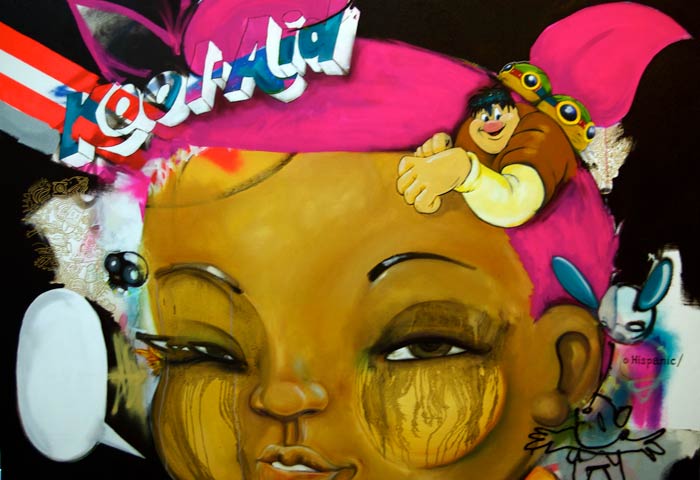
What about your take on your own work?
HB: I think it’s of me, it’s just something that’s very organic. The work has definitely taken its fair share of different directions in my short-lived career and it’s constantly evolving. Personally, I can’t relate to certain images that some Black artist create, because I feel like I’ve seen it before; I feel like it gets stale because they are, in essence, doing what they think people want to see. It’s like hip hop: you have certain artists who are progressive and are always trying to evolve. Then you have those who give you the sixteen bars, the hook and the same style with no substance; a basic formula. I don’t subscribe to the typical formula or what we’re supposed to be doing.
What are some of the specific pieces that are going to be in Afro-Futurist: Impossible View?
HB: Honestly, over the past three months, I’ve just been creating: working and knocking out pieces. As we get closer to the show I work on some pieces—leave others the way they are—and figure out what works thematically…
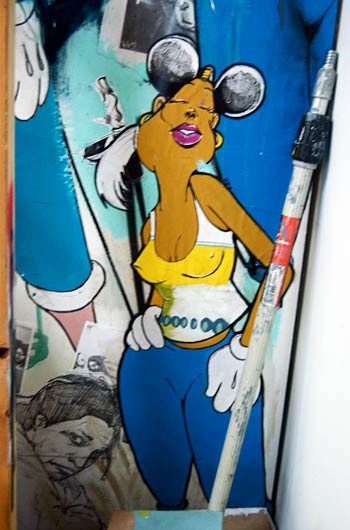
What are some of the themes in this show?
HB: I mean thematically, aesthetically, if it all flows within the confines of the story, the confines of what’s being said I think with this one…it’s hard to get an artist to talk about their work but I think with the work that will make the show, it’ll be very narrative and it will be able to tell a story. I think once you get deeper within a piece you’ll be able to see the subtext and things that are stylized will jump out and get the audience into it.
You deal with children in a lot of your work. In the past you’ve mentioned that you like the dynamism of kids; you’ve talked about them being playful and enjoyable yet the name of your blog is “Whup Yo Kids,” which is on the other end of the spectrum.
HB: These are little people and I respect it as such. Any figurative artist has certain characters they are more comfortable with and are more organic for them to create. I think the exaggerated, cartoonish children , or young adults, flow a bit more natural and it’s an easier way to tell a story. There is a form of innocence to it. Even if they are wielding a knife [Laughs]. I think it allows the viewer to approach the art a little be more lightheartedly.
How do the images correlate with the message of your blog [Whup Yo Kids]?
HB: Whup Yo Kids came out of a place of frustration while living in Chicago and dealing with—or hearing about—all of the B.S. that goes on with kids getting at other kids after school and fights—it getting taped—and kids getting bullied, beat up and it kind of gets outrageous. I don’t necessarily think that the work that I do with kids is that tightly related but it just came out of a place of frustration. To quote De La Soul: “Neighborhoods are now hoods cause nobody’s neighbors/Just animals surviving with animal behavior[Stakes is High].” I think that’s what it is. When you look at some of the work that I do with Mammie Two-Shoes, who is the heroine and the lead, we don’t have that foundation within the family much. This figure [throughout history] has been there to clean, bathe and put down, not only her children, but other families as well. Sometimes you look at some of the stuff that youth does and they just need their ass whooped.
What do you want people to take away from your images?
HB: I don’t have a set thing I want people to take away from the work, I just want it to stay with them. Whatever they leave, whatever that is, I want it to stay with them.
So the regular usage of children in your work could be about a cry to protect the innocence of children?
HB: It’s not necessarily about saving the children. I’m not up here like Jesse Jackson, save the Black community. I’m moreso trying to call attention to everyday things. I use the children, the young adults as just the means in which to tell my story. It’s not just about the kids. A lot of what I put into the work is very relevant to a sixty year old man as it is to a sixteen year old. I don’t want it to be misconstrued. Ultimately I just want to tell stories. I think it’s interesting to put these children in very grown up situations.
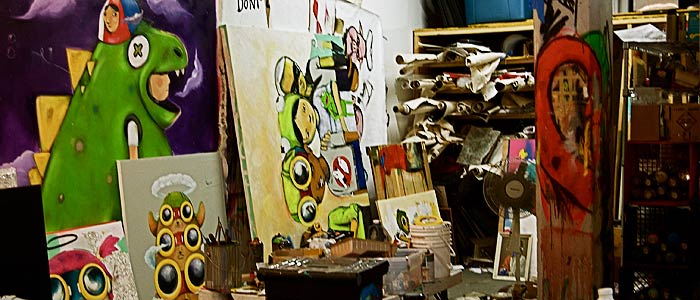
When you start off with a blank canvas, do you have specific characters or stories in mind? Especially if one considers the repetition of some themes, or even characters, that show up in various forms in your work.
HB: The only thing that I set out—when I first started—[to show] the character The FlyBoy which is an iconic character for “the other group,” the Blacks, Latinos—people of color. He can be as all American as Mickey Mouse or Bugs Bunny but it’s us owning it, it’s ours. Through repetition different stories are told. No two characters look the same aside from accessories or things they may be wearing. The goggles, for instance, are like a call to action or taking charge, like a cape or a superhero mask. The FlyBoys were just done from me just staring at a Tuskegee Airmen poster, of real heroes, when I was stuck in a room at a place where I didn’t want to be but I was inspired by them.
Thinkers like Michele Wallace critique mainstream Black art and talk about primitivism [as it relates to Africa] being more widely accepted as valid art in comparison to contemporary, urban images. Is what you deal with purposeful?
HB: I’ve never been to Africa. I want to go but I’ve never been. I know what I’ve seen in history books and I know what I’ve seen in pictures. I know what Picasso stole. I can’t relate to it directly. I always refer to a quote by Romare Bearden when he was saying—and I’m going to misquote him: “…a true artist essentially tells the tales of the time in which they existed..” That’s all I want to to do. This is what I know. When I was a kid growing up, my baby sitter for most of the time was the television. It became that contemporary mode of meditation so a lot of that is a result of, directly or indirectly, what I grew up watching and even today what I taste, touch, eat, see and feel is put into the work.
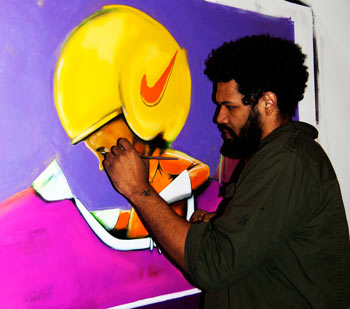
How do people react to your work?
HB: I make this joke a lot but I’m 6’8’’ and I weigh two hundred and fifty pounds, so if someone doesn’t like my work they don’t tell me. I wouldn’t know the negative side of the coin because that’s never been shared with me [Laughs]. Those that get it, get it and they definitely appreciate it and support.
What has the journey been like for you getting from your group showings to your first big solo show?
HB: I think that I was always doing a form of what I do now; I just threaded the line and went around the gamut of different styles. I wanted to test the waters and have more than one trick in my repertoire of paintings so to speak. I didn’t want to be a one-trick-pony, do one particular kind of style, regurgitate that in four years and be well known for that—it’s just like, ugh that’s boring to me. I dabbled. I was essentially that kind of scientist, in a sense that, even if I didn’t feel it, I tried it. I got to a place that was comfortable—not necessarily complacent—with manipulating certain styles and certain language within the work. Within these past two years I can say I have been able to be a full-time artist without many life interruptions. As a result—maybe three hundred paintings later—my largest solo to-date. I plan not to disappoint. It’s only up from here.
I’m curious about your process of creating, you’re working on a painting now (while doing the interview. not missing a beat.), explain this piece.
HB: I use different mediums when I work. I use traditional oils, acrylics and I also blend certain work. Mixed media is my favorite medium [Laughs] but with this piece this is a straight oil piece. Just like every artist you know when something’s missing—this is one of those pieces. With oil paintings sometimes you have to let it sit and then you decide if it’s done or if it needs a little extra. This needed an extra umph. This is called Cosby’s New Family Plan—as in Bill Cosby. With this one you have a plane with three people in it and it’s about what Bill Cosby always talks about and people get upset—the Black Family Structure. Not only the Black community but awareness about the Black community. It’s all kind of going to hell in a hand-basket. The same idea with Whup Yo Kids.
How do you feel about the Chicago art scene?
HB: Chicago’s cool. Like every city, Chicago has its own scene and its own way of doing things. I think that my work here is being received a lot better but maybe I can just attribute that to me getting a lot better? I have no complaints on that level. On a whole Chicago isn’t New York, Los Angeles or Europe. We are that middle child. We get a glimpse of what’s going on and see what sticks. We’re not a place that ushers in many trends. I think, though, that because Chicago is that way it is you have room for expansion and you want progression, something bigger than what’s around you. Chicago moves at its own pace. It’s my city, I was born here and I’ll always love Chicago.
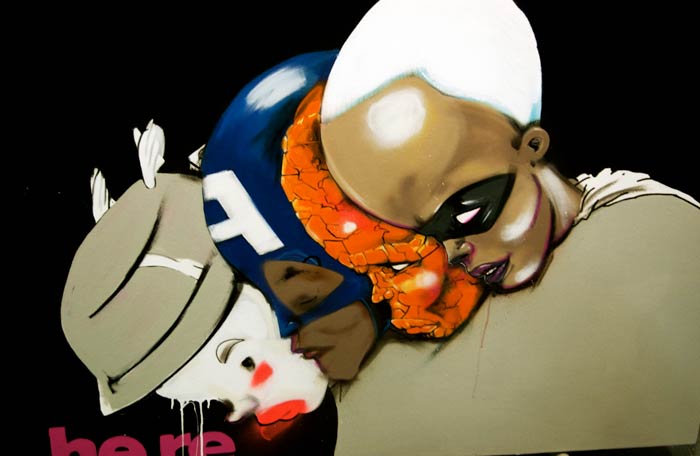
What do you think about the power of your images and how people are impacted by them?
HB: I don’t think my images have that much power. I wouldn’t really know how to answer that. It’s something I don’t really think about…
Another artists walks in to ask Hebru to give his opinion on her work when he is finished with the interview. He agrees and continues to paint.
Yea, but when you think about representations and how the images you use have been—at times—exploitative and not, perhaps, used to uplift Blackness.
HB: I think that depends on the person. An artist like Kara Walker, you might look at her work and feel empowered while others look at it and call her a racist and completely hate it. On an everyday basis I don’t necessarily think about the reaction that people are going to have. Some people see my work and they tell me they love it but it’s not something I think about often.
What are we going to get from this show?
HB: Me, honestly.
What parts of you?
HB: Whatever you take away. Whatever parts you feel you got. This is who I am. When you bought a Miles [Davis] album, depending on the time, you got whatever was going on. You got that pain. You got drug induced concertos and whatever else have you but you got Miles. With this you get me. This is who I am, what I am. All I can do is put it out there and let people talk shit about it and tear it to pieces or tell me what I was supposed to be doing or what I was setting out to do. It’s part of art; it’s part of the process.
How many pieces will you display?
HB: Don’t know yet. Fifteen? Thirty? Fifty?. We’re going to see what works. As of right now maybe thirty finished pieces and maybe fifty unfinished. We have a lot of decisions to make.
What else is going to be happening in your world?
HB: You’re going to see more of the kid. I’m going to let people know how much of a fucking BEAST I am. More shows. More street art. More fun. More merchandise, products and a lot of great work to come. You can see my work at my shows and my website.
Check out http://www.hebrubrantley.com to see more work and upcoming shows.
His newest body of work Afro-Futurisms: Impossible View:
Zhou B Art Center, 1029 W. 35th ST, Chicago IL 60609.
Exhibition opens Friday March 18th 6-10pm and will run through April 25th
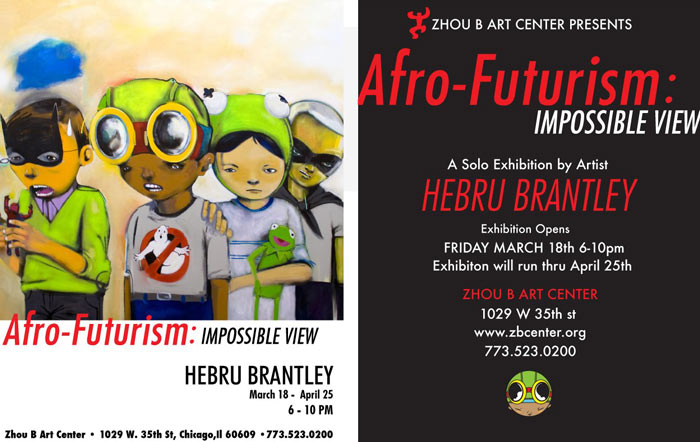
I honor this artist for making a commnet to perserve priceless principles and ideals that have sustained generation in front of us…….. Keep discovering people as such Mark!
Great article!